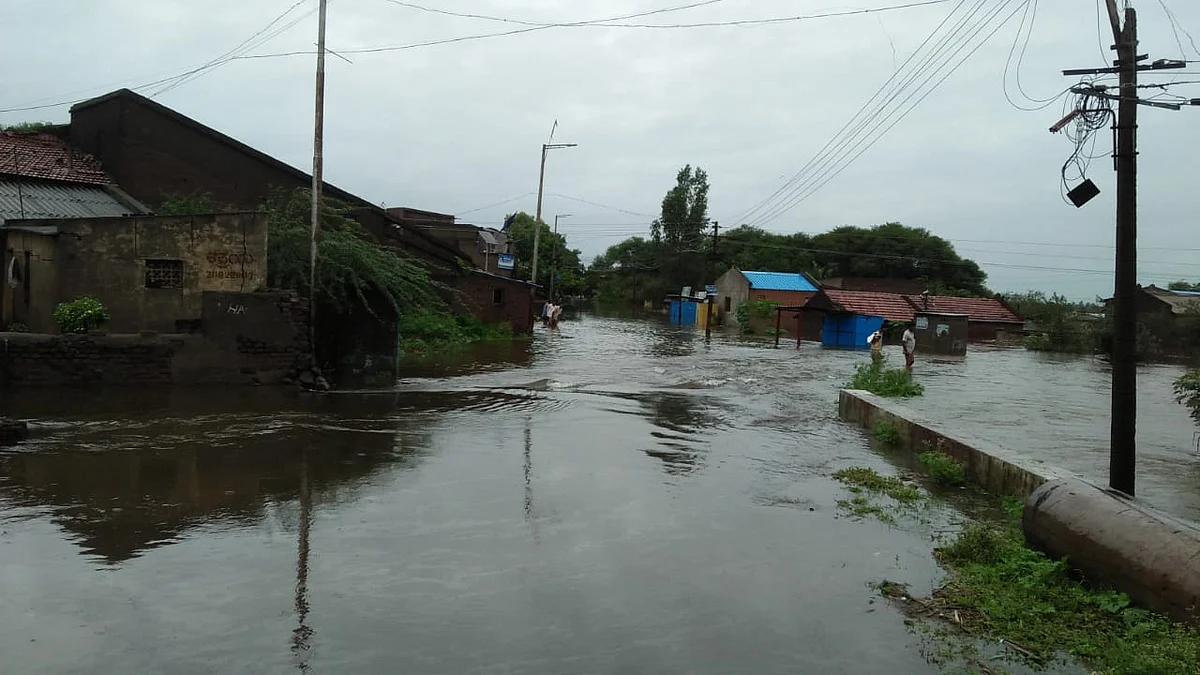Drought to Floods: Behind Karnataka’s Extreme Weather Conditions
With several submerged districts receiving not excess, but deficit rains this time, what explains this aberration?

advertisement
Speaking in the Legislative Assembly last December, Revenue Minister RV Deshpande reportedly said that 16 of the country’s 24 ‘permanently drought-prone districts’ were in Karnataka. Belagavi and Bagalkote districts had made it to this list.
Too busy to read? Listen to the story instead!
Since 1 August, 48 people lost their lives in recent floods with 13 belonging to Belagavi. Belagavi has been the worst affected district this year, witnessing over 4 lakh people being evacuated and thousands of hectares of crop loss.
CM Yediyurappa has said that flood-related losses could amount to Rs 30,000 crore state-wide and has requested that Rs 3,000 crore is released urgently for relief works.
On 15 June, former CM Kumaraswamy had approached PM Modi, seeking Rs 2,434 crore for drought relief, owing to a pre-monsoon deficit by 45 percent with 100 taluks declared as ‘drought-affected’.
As of 5 August, only 3 districts – Belagavi, Bagalkote and Dhadwad – had received excess rains according to the data maintained by the Karnataka State Disaster Monitoring Centre.
Eleven districts recorded normal rains while sixteen others had recorded deficient rainfall.
Two days later, data by the Indian Meterological Department suggests that for the week ending 7 August, 16 districts had recorded 60 percent rains or more than the average.
Within two days, Karnataka went on from having 16 districts receiving deficit rains to 16 districts receiving excessive rains.
Even till 12 August, the IMD data stated that districts like Raichur, Yadgir and Dakshina Kannada had received less than average rains this monsoon season. But the ground reality was different, two people had lost their lives to the flood while over 3,000 had been evacuated from these districts.
The answer lies in shorter rainy days, deforestation and development activities in catchment areas of rivers compounded by the excess water coming to the state from Maharashtra through Kolapur and other areas.
Shorter Rainy Days Wreaking Havoc
According to Geeta Agnihotri, director-in-charge of IMD Bengaluru, the current situation is because of showers, supposed to come over 122 days of the monsoon, starting 1 June, coming over a course of 2-3 days.
A Down to Earth report states that Karnataka received five times the rain that it ordinarily does on a single day on 8 August. It also noted that Kodagu received 180.3 mm of rain, amounting to nearly 700 percent more than the normal.
“In North Karnataka, there was deficient rainfall for the last few years. When the season’s expected rainfall takes place over a few days, it causes devastation. While the deficiency has been made up, there is a lot of rainfall damage,” she said. Agnihotri added that extremely fast winds along the western coast had pushed the currents inward and supplemented an already active weather system over central India.
Deforestation Reduced Soil Resilience, Ability to Retain Water
Professor TV Ramachandra from the Centre of Ecological Sciences, IISc, said that deforestation had aggravated the flood conditions of Uttara Kannada and the west coast.
Bengaluru-based water expert S Vishwanath said that recent floods have revealed the lack of soil resilience.
“This shows that the land was incapable of retaining so much water received over a short period of time. Thus, we have this aberration of taluks being flooded with average or deficit rains,” he said.
Mismanagement of Catchment Areas
Professor Ramachandra who has done critical work and analysed the catchment area of the Kali river that originates in Uttara Kannada said that mismanagement in the catchment areas of rivers bore 60 percent of the blame for the current situation, while climate change was also responsible for lesser number of rainy days.
In his paper titled ‘Eco-Hydrological Footprint of a River Basin in Western Ghats’ that was published in the Yale Journal of Biology and Medicine, Prof Ramachandra observed “the need for integrated approaches in the river basin management in an era dominated by mismanagement of river catchment with the enhanced deforestation process, inappropriate cropping, and poor water efficiency. The premium should be on conservation of the remaining evergreen and semi-evergreen forests, which are vital for the water security (perennial streams) and food security (sustenance of biodiversity).”
The catchment area of Kali river basin extends from Uttara Kannada to Dharwad and then Belgaum, and is currently reeling under floods.
Vishwanath also added that excessive road cutting for development works had resulted in water silting up, thus, reducing the flow.
(With inputs from Down to Earth and the Hindu)
(At The Quint, we question everything. Play an active role in shaping our journalism by becoming a member today.)